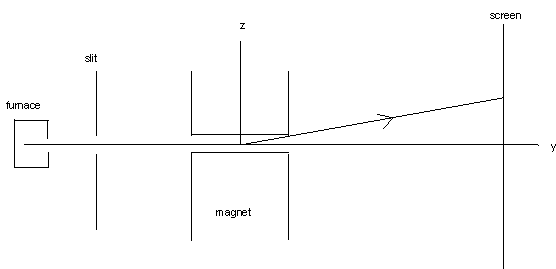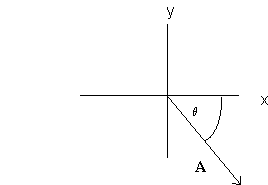

Assume a Stern-Gerlach type experiment is performed with an apparatus as shown in the figure.

A beam of silver atoms emerges from a furnace held at 1000 K. It is collimated using 0.1 mm slits, passed between the poles of a magnet, and directed onto a screen, where the atoms are detected. The speed of the silver atoms is approximately 500 m/s (from (3/2)kT = ½mv2), k = 1.38*10-23 J/K). Assume the apertures collimate the beam to approximately 0.1o angular spread. The spread in the component of velocity perpendicular to the beam direction is at least 1 m/s since Δvz = (500 m/s)*sin(0.1o). We have ΔvzΔz ≥ 10-4 m2/s. The uncertainty principle requires that ΔvzΔz ≥ ħ/M ≈ 10-10 m2/s. (Msilver = 1.6*10-27 kg * 108.) The position and momentum of a particle must be treated quantum-mechanically when ΔpiΔri approaches the minimum value required by the uncertainty principle. In a typical Stern-Gerlach type experiment this is not the case. The external degrees of freedom of the silver atoms can be treated classically. The dimensions of the wave packet are much smaller that the characteristic dimensions of the problem.
Assume each silver atom has a permanent magnetic moment m. We assume that m = γS, where S denotes the intrinsic angular momentum of the silver atom. γ is called the gyromagnetic ratio. If m is a fundamental property of the atom, then its total energy in an external magnetic field is W = -m∙B. The torque on the atom is τ = m×B, and the force is F = ∇(m∙B).
| In our experiment B = (Bx, 0, Bz) is an inhomogeneous
field. In the region of interest, where the beam passes through the field, we have
Bz >> Bx, B ≈ Bk.
Therefore τ = m×Bk, τ = dS/dt = γS×Bk. dSx/dt = γBzSy, dSy/dt = -γBzSx, dSz/dt = 0. The component Sz is constant, while the component perpendicular to the z-axis rotates about the z-axis. |
 |
Consider an arbitrary vector A, rotating cw about the origin in the x-y plane with angular velocity ω = dθ/dt.

Ax = Acosθ, Ay = -Asinθ,
dAx/dt = (dAx/dθ)(dθ/dt) = -Asinθω, dAy/dt
= (dAy/dθ)(dθ/dt) = -Acosθω.
dAx/dt = ωAy, dAy/dt = -ωAx.
S⟂ rotates about the z-axis with angular
velocity ω = |γBz|. For positive γBz
it rotates cw, and for negative γBz it rotates ccw.
The z-component of F acting on the silver atoms is
Fz = ∂/∂z(mzBz
+ mxBx) ≈
∂/∂z(mzBz) = mz∂Bz/∂z.
Fz produces a deflection of the atoms in the z-direction which
is proportional to mz. If
∂Bz/∂z is known, then measuring this deflection is equivalent to measuring mz.
Classically, we expect to find all values of mz between mz
= +|m| and mz= -|m|.
In the experiment the silver atoms hit the screen in two distinct spots.
The
measurement yields only two possible values for mz. Sz is
therefore a quantized observable, whose discrete spectrum has only two eigenvalues, which
we will find to be ±ħ/2.
In quantum mechanics, every measurable physical quantity is associated
with a Hermitian operator whose eigenvectors form a basis for the state space.
Assume that
Sz is the observable associated with the z-component of the spin.
The state space corresponding to the observable Sz of a Silver atom (a
spin ½ particle) is therefore two-dimensional.
We denote the eigenvectors of Sz
by |+> and |->.
Sz|+> = (ħ/2)|+>, Sz|-> = -(ħ/2)|->.
We assume that the eigenvectors are normalized.
<+|+> = <-|-> = 1, <+|-> = 0.
Sz alone is a C.S.C.O. in the state space Espin spanned by the
vectors |+> and |->. The closure relation is written as
|+><+| + |-><-| = I.
The most general element of Espin is |ψ> = a|+> + b|->. If <ψ|ψ>
= 1, then |a|2 + |b|2 = 1.
The matrix of Sz in the {|+>, |->} basis is
 .
.
The complete state space for a particle is E = Espace ⊗ Espin. However, if in a given problem the spatial degrees of freedom can be treated classically, then we can predict the outcome of measurements which depend on the internal degrees of freedom by considering only the state vector in Espin.
Let Sx and Sy denote the observables associated with the x- and y-components of the spin of a spin ½ particle, and Su = S∙u the observable associated with the component along a direction defined by the unit vector u . Espin can also be spanned by the eigenvectors |±>x of Sx, |±>y of Sy, or |±>u of Su. However, Sx, Sy, and Sz do not commute, they are incompatible observables. The eigenvectors of Si are not eigenvectors of Sj and Sk. The matrices of Sx and Sy in the eigenbasis of Sz , {|+>, |->}, are not diagonal. Theoretical predictions agree with observations if (Sx) and (Sy) in the {|+>, |->} basis are given by
 ,
,
 .
.
We write S = (ħ/2)σ. The matrices of the three components of σ in the {|+>, |->} basis are called the Pauli matrices.

The eigenvalues of σx and σy are ±1.
The eigenvectors of σx are |±>x =
(1/√2)(|+> ± |->),
and the
eigenvectors of σy are |±>y = (1/√2)(|+> ±
i|->).
These are also the
eigenvectors of Sx and Sy .
Properties of σx and σy and σz
det(σi) = -1,
Tr{σi} = 0, σi2 = I, σxσy
= -σyσx = iσz.
In general, σiσj = iεijkσk
+ δijI, [σi,σj] = i2εijkσk.
Therefore
[Sx,Sy] = iħSz,
[Sy,Sz] = iħSx, [Sz,Sx] =
iħSy,
since S = (ħ/2)σ. We have already shown that [Ji,Jj] = iħεijkJk
are commutation
relations for angular momentum.
The Pauli matrices anti-commute, (σiσj + σjσi)
= 0.
We also find σxσyσz = iI.
Any arbitrary 2 by 2 matrix can be written as a linear combination of the four matrices σx, σy, σz and I.
Let  be an arbitrary 2
by 2 matrix.
be an arbitrary 2
by 2 matrix.
M = ½(m11 + m22)I + ½(m11 - m22)σz
+ ½(m12 + m21)σx + (i/2)(m12 - m21)σy
= a0I + azσz + axσx +
ayσy.
(M) is a Hermitian matrix if a0, ax, ay,
and az are real.
a0 = ½Tr{M}, a = ½Tr{Mσ}.
The operator Su is defined through
S∙u = Sxsinθcosφ
+ Sysinθsinφ + Szcosθ.
The matrix of Su is (Su) = (Sx)sinθcosφ
+ (Sy)sinθsinφ + (Sz)cosθ
=  .
.
The eigenvectors of Su are
|+>u = cos(θ/2)exp(-iφ/2)|+> + sin(θ/2)exp(iφ/2)|->,
|->u = -sin(θ/2)exp(-iφ/2)|+> + cos(θ/2)exp(iφ/2)|->.
The most general normalized ket in the spin state space Espin is |ψ> = a|+> + b|->, |a|2 + |b|2 = 1. |ψ> is the eigenvector of some operator Su with eigenvalue ±ħ/2. There exists a unit vector u and an operator Su such that |ψ> =|+>u. An arbitrary state vector can be written as |ψ> = cos(θ/2)exp(-iφ/2)|+> + sin(θ/2)exp(iφ/2)|->.
A system can be prepared in any state |ψ> by placing a Stern-Gerlach apparatus such that its axis is directed along the unit vector u and letting only the upward deflected particles pass.